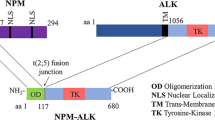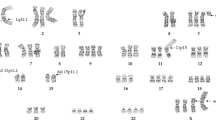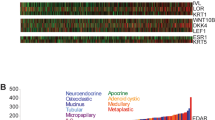Abstract
The brk gene encodes a non-receptor protein tyrosine kinase that consists of single SH3, SH2 and catalytic domains. Although BRK shows strongest sequence similarity to members of the SRC family of PTKs, there are several key structural and regulatory differences that place it on its own amongst non-receptor PTKs. In this study we have isolated genomic DNA clones corresponding to the human brk locus and used these to determine the intron-exon structure of the brk gene. The genomic structure of brk consists of 8 exons, whose boundaries are distinct from other non-receptor PTK family members, again indicating a structural and functional divergence. Alternate splicing of the primary brk transcript generates a distinct mRNA which encodes a truncated protein consisting of an SH3 domain and a novel C-terminal proline rich sequence. Using an antiserum raised to the SH3 domain, we have demonstrated that the product of this alternate brk transcript is expressed in the human breast tumour cell line T-47D. We have previously reported that expression of a tumour derived brk cDNA in mouse embryonic fibroblasts and human mammary epithelial cells supports anchorage independent growth, and in the latter potentiates the mitogenic response to epidermal growth factor. The protein encoded by the genomic sequence derived from normal human tissue is identical to that encoded by the tumour derived cDNA, and therefore the altered growth regulation is not associated with mutations within brk. In addition, we have identified a 5′ genomic region that has promoter activity. The brk gene has been assigned to chromosome 19q 13.3-13.4 using fluorescence in situ hybridisation (FISH).
This is a preview of subscription content, access via your institution
Access options
Subscribe to this journal
Receive 50 print issues and online access
$259.00 per year
only $5.18 per issue
Buy this article
- Purchase on Springer Link
- Instant access to full article PDF
Prices may be subject to local taxes which are calculated during checkout
Similar content being viewed by others
Author information
Authors and Affiliations
Rights and permissions
About this article
Cite this article
Mitchell, P., Barker, K., Shipley, J. et al. Characterisation and chromosome mapping of the human non receptor tyrosine kinase gene, brk. Oncogene 15, 1497–1502 (1997). https://doi.org/10.1038/sj.onc.1201292
Received:
Revised:
Accepted:
Issue Date:
DOI: https://doi.org/10.1038/sj.onc.1201292
Keywords
This article is cited by
-
Prognostic impact of PTK6 expression in triple negative breast cancer
BMC Women's Health (2023)
-
Constitutive activation of breast tumor kinase accelerates cell migration and tumor growth in vivo
Oncogenesis (2012)
-
Identification of STAT3 as a specific substrate of breast tumor kinase
Oncogene (2006)
-
Brk
AfCS-Nature Molecule Pages (2005)
-
Expression of the BRK tyrosine kinase in mammary epithelial cells enhances the coupling of EGF signalling to PI 3-kinase and Akt, via erbB3 phosphorylation
Oncogene (2000)



